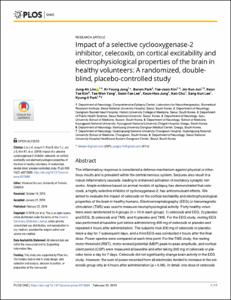Impact of a selective cyclooxygenase-2 inhibitor, celecoxib, on cortical excitability and electrophysiological properties of the brain in healthy volunteers: A randomized, double-blind, placebo-controlled study
- Affiliated Author(s)
- 김근태
- Alternative Author(s)
- Kim, Keun Tae
- Journal Title
- PLoS One
- ISSN
- 1932-6203
- Issued Date
- 2019
- Abstract
- The inflammatory response is considered a defence mechanism against physical or infectious insults and is prevalent within the central nervous system. Seizures also result in a robust inflammatory cascade, leading to enhanced activation of excitatory synaptic networks. Ample evidence based on animal models of epilepsy has demonstrated that celecoxib, a highly selective inhibitor of cyclooxygenase-2, has anticonvulsant effects. We aimed to evaluate the impact of celecoxib on the cortical excitability and electrophysiological properties of the brain in healthy humans. Electroencephalography (EEG) or transmagnetic stimulation (TMS) was used to measure neurophysiological activity. Forty healthy volunteers were randomized to 4 groups (n = 10 in each group): 1) celecoxib and EEG, 2) placebo and EEG, 3) celecoxib and TMS, and 4) placebo and TMS. For the EEG study, resting EEG was performed at baseline just before administering 400 mg of celecoxib or placebo and repeated 4 hours after administration. The subjects took 200 mg of celecoxib or placebo twice a day for 7 subsequent days, and a third EEG was conducted 4 hours after the final dose. Power spectra were compared at each time point. For the TMS study, the resting motor threshold (RMT), motor evoked potential (MEP) peak-to-peak amplitude, and cortical silent period (CSP) were measured at baseline and after taking 200 mg of celecoxib or placebo twice a day for 7 days. Celecoxib did not significantly change brain activity in the EEG study. However, the sum of power recorded from all electrodes tended to increase in the celecoxib group only at 4 hours after administration (p = 0.06). In detail, one dose of celecoxib (400 mg) transiently and significantly increased the alpha band power recorded in the frontal and parietal areas as well as in the whole brain (p = 0.049, 0.017, and 0.014, respectively) and the beta frequency in the central and parietal regions (p = 0.013 and 0.005, respectively), whereas the placebo did not. This effect was abolished after 7 days of treatment. In the TMS study, we found no statistically significant change in the RMT, MEP peak-to-peak amplitude or CSP. This evidence suggests that celecoxib transiently alters the electrophysiological properties of the brain but does not suppress neuronal excitability in healthy humans.
- Department
- Dept. of Neurology (신경과학)
- Publisher
- School of Medicine (의과대학)
- Citation
- Jung-Ah Lim et al. (2019). Impact of a selective cyclooxygenase-2 inhibitor, celecoxib, on cortical excitability and electrophysiological properties of the brain in healthy volunteers: A randomized, double-blind, placebo-controlled study. PLoS One, 14(2), e0212689–e0212689. doi: 10.1371/journal.pone.0212689
- Type
- Article
- ISSN
- 1932-6203
- Appears in Collections:
- 1. School of Medicine (의과대학) > Dept. of Neurology (신경과학)
- 파일 목록
-
-
Download
 oak-2019-0065.pdf
기타 데이터 / 1.72 MB / Adobe PDF
oak-2019-0065.pdf
기타 데이터 / 1.72 MB / Adobe PDF
-
Items in Repository are protected by copyright, with all rights reserved, unless otherwise indicated.